This is part 2 of a 5-part travel series on Ubud where I share things to note as a foreigner living in Ubud and how to make the best out of your trip here.
- Part 1: Living in Ubud Series: Introduction, Visa, Accommodation
- Part 2: Environment: Nature, Climate, Villages, Animals
- Part 3: Transport: Scooters, Taxis, Go-Jek
- Part 4: Food: Vegan & Vegetarian Restaurant Reviews
- Part 5: Others: Insects, Language, Internet Speed, and More (Conclusion)
Ubud: Living in Nature
Ubud is beautiful with tons of forests and greenery. Living in the countryside, it was every bit the dream getaway I had in mind.
- Tons of space? Check.
- Lots of greenery? Check.
- Calming peace, void of noises like endless construction and whizzing traffic? Check.
- Nature sounds? Check.
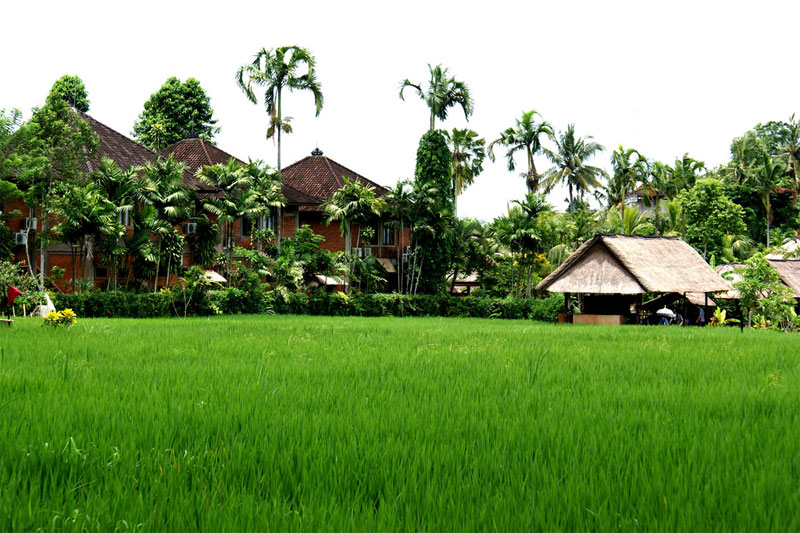
Ubud is filled with lush greenery and rice fields
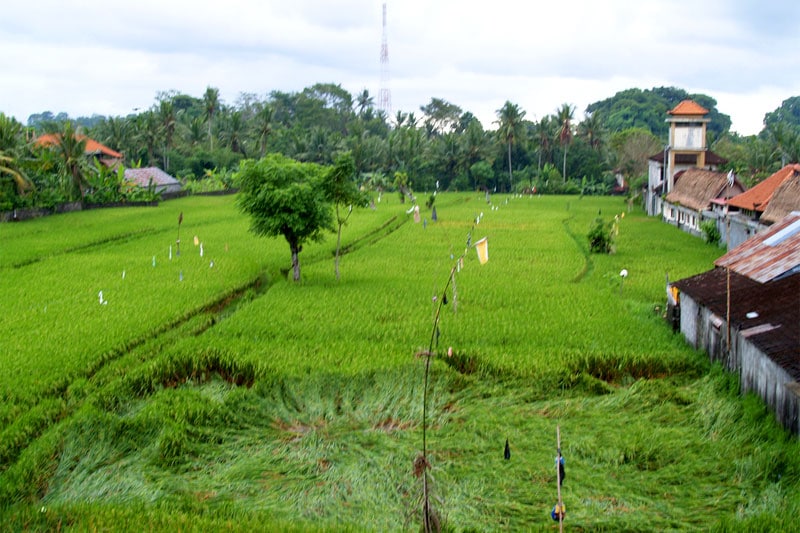
One of the many rice fields in Ubud
I find the nature sounds especially welcoming. Whether you’re living in the countryside or Ubud Center, every morning you will hear rooster calls, followed by birds chirping throughout the day. If you’re living in the countryside, you will hear crickets chirping every evening. I find these incredibly therapeutic and calming.
These are things that you don’t hear in a busy city; instead, the usual sounds in Singapore are loud roaring engines of buses and whizzing sounds of automobiles when the morning starts, the clanking of machinery and drilling as yet another construction is underway, and people talking loudly into the night if you live at public estates. It’s a problem in a stressed-up city and busy where there is no concept of proper sleeping hours.
In Ubud, I automatically turn in at 11+pm at night and wake up at 6-7 am to nature sounds (sometimes earlier). In Singapore, I would find it hard to have a good night’s rest if I was living in a busy estate with constant background noise (of which many public estates would have this issue because of how intensely packed the city is now becoming).
Bali Climate — Months to Visit, Months to Avoid
Ubud/Bali, being near the equator, has a tropical climate. Average year-round temperature is around 30°C with a humidity level of about 85%.[1] The sun is usually scorching between 10 am and 4 pm each day. If you’ve been in South East Asia before, the climate is about the same here.
In May, the sun rises at about 6:30 am each day and sets at 6 pm. It gets dark quickly after 6 pm and there are no street lamps, so you don’t want to be walking alone in the villages if you’re not familiar with the place. In Ubud Center, that’s fine as people are still walking around even at 8, 9 pm since many international cafes close at 10 pm.
When I was there in early November, I noticed that the sun would rise very early at about 5:30 am and set at 7 pm. Towards the end of November, the sun started setting at about 6:30 pm.
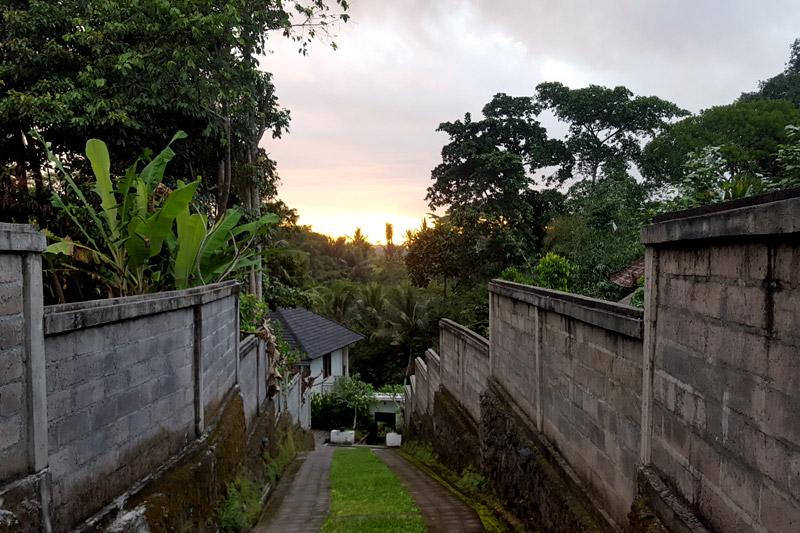
View of the sunset where I’m staying
Seasons in Bali
There are two seasons in Bali: the dry and monsoon seasons. The dry season is May-September while the monsoon season is October-March.
For May, the weather is pretty good. Sunny almost every day and cloudy every few days. It rains every three to four days for an hour or two, usually in the late evening or at night.
For November, I found the weather pretty similar to May for the first three weeks. Rainfall isn’t an issue for those three weeks. Like in May, the first three weeks of November are sunny in the day and rains every few days at night (after 10 pm or midnight) when you should be back home anyway. But it gets really rainy in the last week and you need sneakers and an umbrella to get around. I wouldn’t recommend staying past the third week of November if you’re here to tour.
Bali receives the most visitors in July and August, so visit during May or September to avoid the busy months. I think visiting during October and November are pretty good options too (except for the last week of Nov) — and being off-peak, you can negotiate good prices on Airbnb.

The monthly temperature and precipitation in Bali. The months with the heaviest rainfall are November-March. (Image: Wiki Travel)
Tremors, Earthquakes
Because Indonesia is prone to natural disasters such as earthquakes, you may experience some tremors while in Ubud.
During my November 2018 trip, I experienced some tremors. They usually happened at night. Basically, the entire building would be shaking while the doors would be knocking against their hinges/brackets. They never lasted more than a few minutes and were quite mild.
On my day of departure (in December), there was a strong tremor that lasted for a few minutes. It actually felt a bit scary when the shaking wouldn’t stop and got worse. When I looked up the internet, I found out that an earthquake of magnitude 5.7 had just happened in the Sumbawa region of Indonesia. I don’t think full-on earthquakes happen in Ubud though, just that you may experience the aftereffects of the earthquakes in neighboring regions.
Ubud Center: Foreigner Central
As I mentioned in part one, Ubud has a main shopping district called Ubud Center. It’s where you find cafes, restaurants, shops selling anything from clothes to jewelry to baked goods, convenience stores, backpacker hostels, massage services, and supermarkets. This entire district is really a tourist district, not a place where true locals visit. It’s also very near the Sacred Monkey Forest Sanctuary, a major attraction in Ubud.
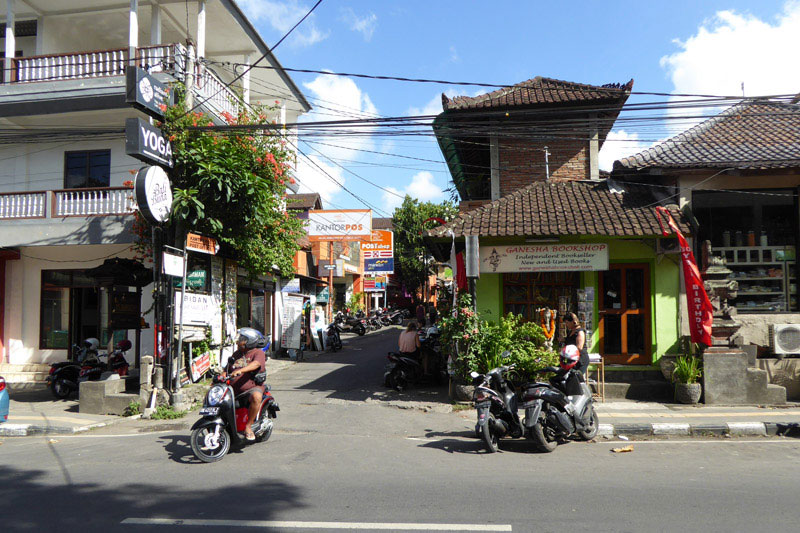
This is Ubud Center. It has one main street which breaks into small streets with restaurants, shops, and cafes.
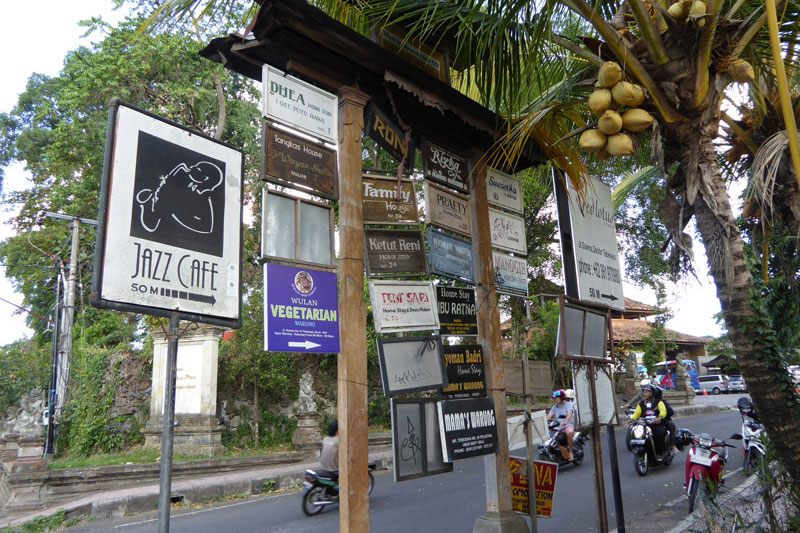
Signboards telling you the shops you can find along that street
What interests me about Ubud Center is the vegan restaurants. The other services like massage, clothing stores, jewelry stores, tourist services, etc. don’t interest me since I’m not there to tour. By the way, I saw a Nike outlet there! Hopefully brands like McDonald’s don’t start springing up here.
Air Pollution; Bad Air Quality
After walking along the streets in Ubud Center for a few weeks, I noticed that the air quality is terrible. Firstly, the vehicles are not fitted with an air filter so the fumes pollute the air whenever a vehicle passes by. Secondly, many guys in Ubud smoke and they are often sitting or standing on the pavements, smoking. Thirdly, depending on when you are there, there would be a smog smell (ranging from light to heavy) in the air. When I was there, there was a heavy smog smell starting from late November and it was there until I left in early December. I’m not sure where it was from but I could smell it throughout Ubud Center, even from my accommodation.
Because of this, I started to dislike walking in Ubud Center after a while. The air quality was generally great at my place other than the smog which started from late November. If you’re here for a long stay, I recommend you bring a good quality face mask so that you can use it as needed.
Targeted at Foreigners
The locals here don’t visit the Ubud Center. In general, the locals you would see here are those involved in tourist operations in some way. After looking at the menu prices at a restaurant (costing 25-35k rupiah or USD 1.8-2.6 for a meal), my driver (who is a simple local man) told me that it’s just too expensive. 25-35k rupiah for a meal is considered the lowest end for meals in Ubud Center; most meals here are easily 50k rupiah and up, even reaching 80-100k rupiah for international restaurants. He says he doesn’t come to Ubud Center except to drive tourists.
Hence walking in Ubud Center, I noticed that everyone was a tourist — Caucasians, Japanese, Chinese, and even Singaporeans. At the supermarket, most if not all the people there were foreigners. The only locals were the staff themselves.
I would also be constantly solicited with services — with massage and taxi being the key ones — while walking in the central area. This happened every 15-30 seconds. Almost all the shops in Ubud Center are targeted at foreigners. Occasionally I came across beggars asking for money, but this only happened along the super busy streets.
I think the locals generally stay in villages and buy the stuff they need from the warungs (small shops/cafes) in their community. Locals are also self-sufficient with their rice paddy fields where they harvest their own rice.
Villages
Around Ubud Center are many villages. This is where the locals live and where you find many rice fields, lots of nature, and the calming tranquility that you read about Ubud. :) From Wiki Travel:
While Ubud seems to outsiders like one small town, it is in fact fourteen villages, each run by its own banjar (village committee). […] Growth continues apace, but there are still terraced rice fields along the rivers, and away from the town centre, regular, quiet village life carries on relatively undisturbed.
The villa I stayed at in 2016 was in a village called Tegallalang. It’s 10 minutes away from Ubud Center by scooter.
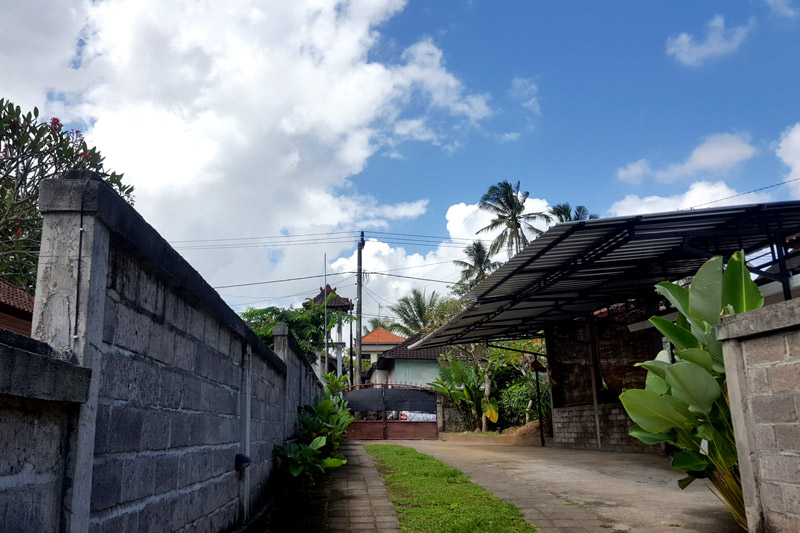
View when I walked out of the place every day — clear view of the sky
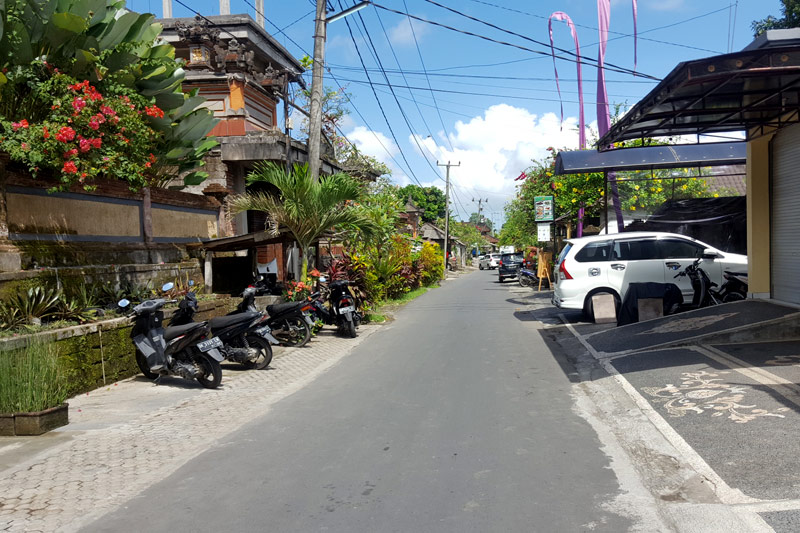
Quiet road with occasional motorists. There is usually a cafe or restaurant along one of the roads.
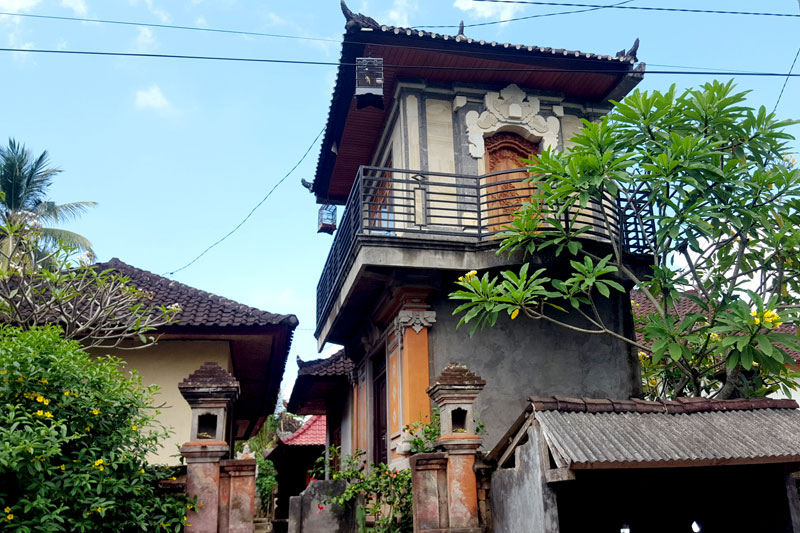
One of the homes in the village. Homes here are big and spacious, a big contrast to urban cities. Apparently, the people here own their land and pass it down across generations.
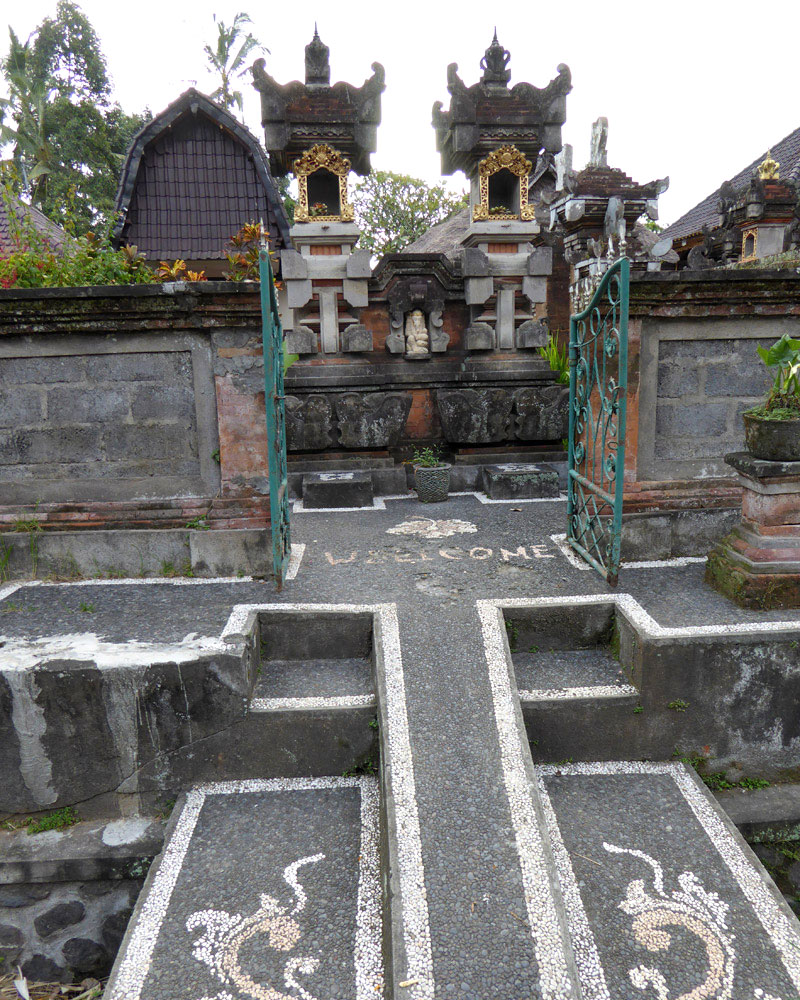
Entrance to a traditional Balinese home. The home designs here look more like temples!
I noticed ad-hoc construction going on whenever I traveled out of the village to the town center. My guess is that it’s the residents building villas to house tourists as a source of income, given that the Ubud tourism industry is booming (thanks to Eat Pray Love). It’s also common for foreigners to buy land here and invest in it for tourism, which I guess is happening around the world. The villa I stayed at is owned by a local and was newly constructed a year ago.
Beautiful Rice Fields
Rice fields are everywhere here, with the most famous one being the Tegalalang Rice Terrace.
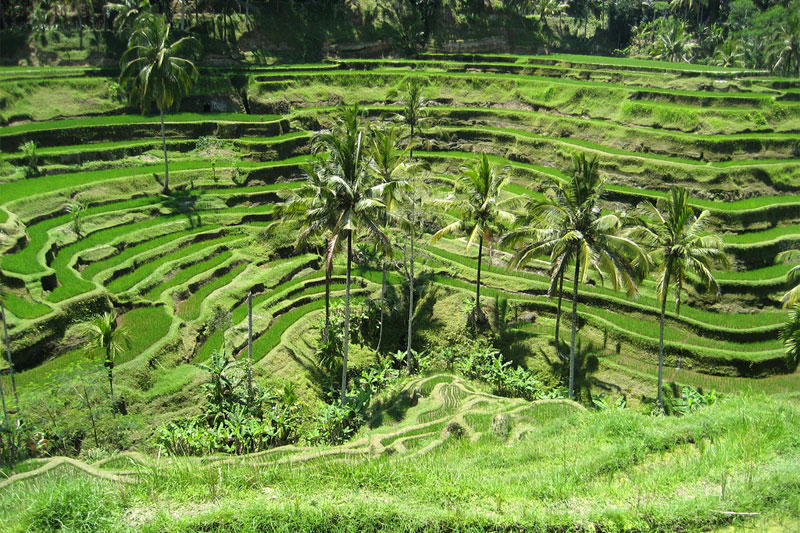
Beautiful rice field terrace in Tegalalang
Besides the Tegalalang rice fields, which is quite commercialized (you’ll be asked for a donation to walk through the fields), you can see rice fields of all shapes and sizes around Ubud. These are owned by the locals themselves.
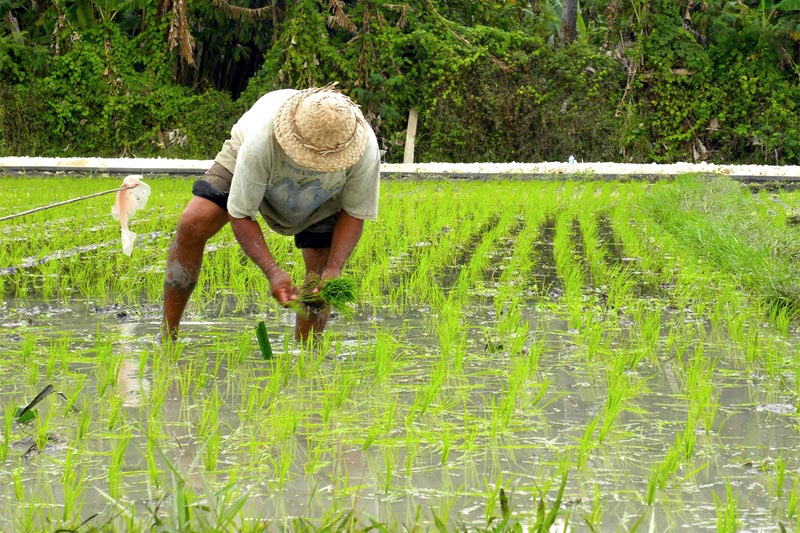
A farmer harvesting rice in his rice paddy field — a common sight in the villages
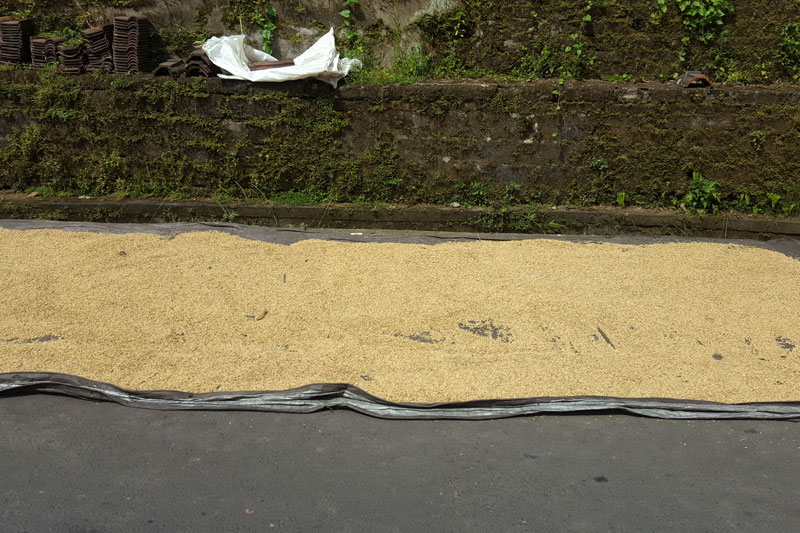
Rice being dried in the sun before it is sent for milling to remove the husk. You will see this everywhere in the countryside, along many roads.
“Canang Sari” — A Daily Blessing
Living in Ubud/Bali, you will see beautiful small pallets made of leaves and filled with flowers and sometimes a candy/biscuit and incense stick when walking around. These pallets can be found everywhere — on the ground, in front of homes, at the entrance of restaurants, on top of shrines, on car/motorcycles, on cashiers, and along the roads at Ubud Center.
They are a Balinese offering called Canang sari. Balinese women make them every day as a daily offering to Sang Hyang Widhi Wasa, the god of Indonesian Hinduism. It’s to ward off demons, attract prosperity, and honor ancestors.[2]
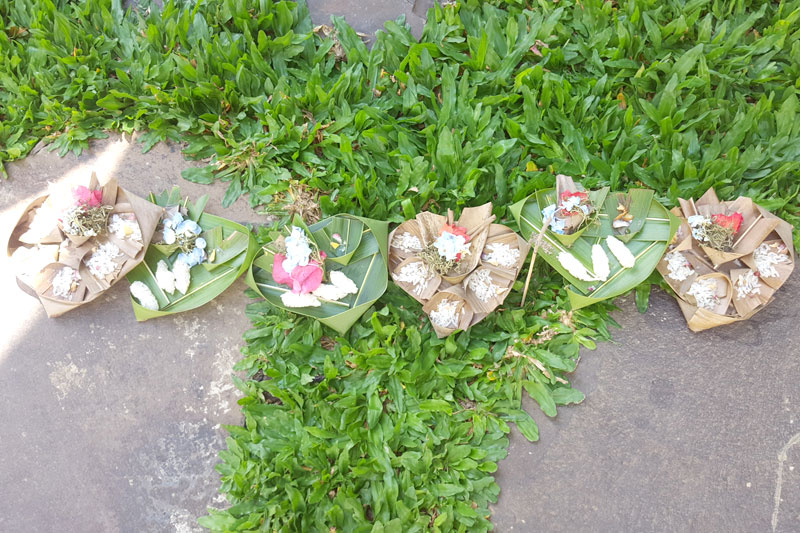
Canang saris are sometimes arranged in a row
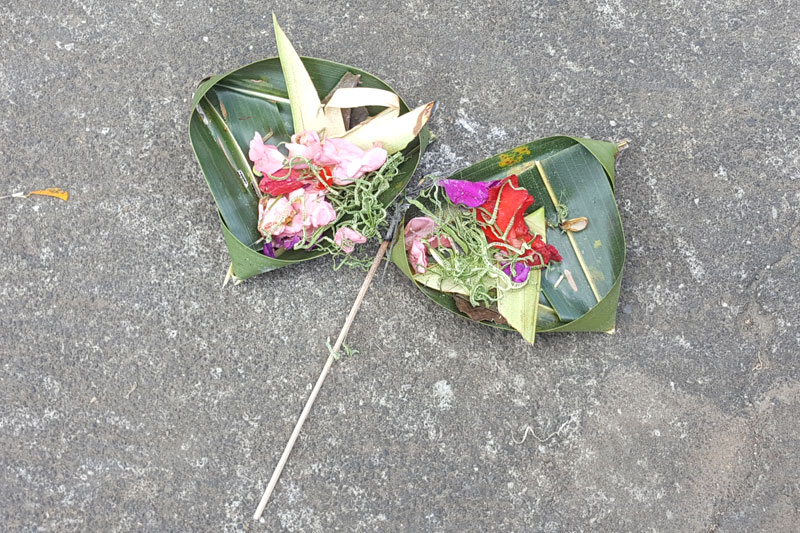
Sometimes they appear in a pair or in threes
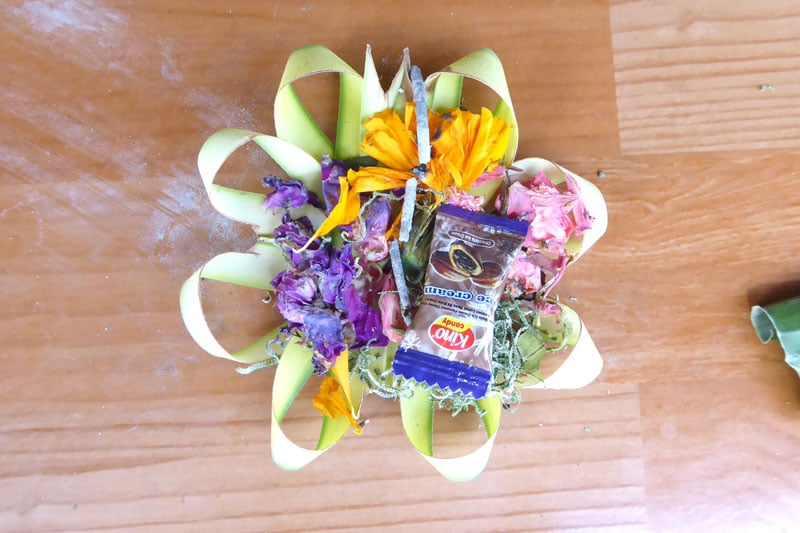
But most of the times they appear singularly
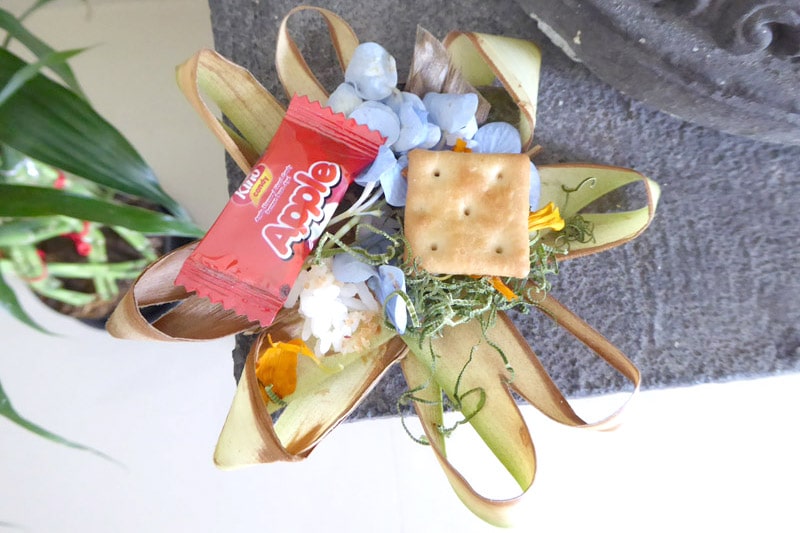
The canang sari is made by hand — a palm leaf is used to create the tray, which is in turn filled with petals and incense. Occasionally you see other offerings inside. Here, it’s rice, a small biscuit, and a candy.
Apparently, there is significance behind the color of the flowers and the direction they point to. Each direction symbolizes a Hindu God.[3]
Every morning, you will see freshly made canang sari greeting you as you walk out of your home and onto the roads. :D Because it’s handmade, every canang sari is different. I came to really like them — the intricately made pallets and delicately placed offerings give me a feeling of calmness!
Warungs
Warungs, which are small shops, can be found in every other street in the villages. They sell daily necessities like shampoo sachets and food like snacks, bananas, and bread. There is a different kind of warung that sells cooked food like nasi goreng (fried rice) and mie goreng (fried noodles).
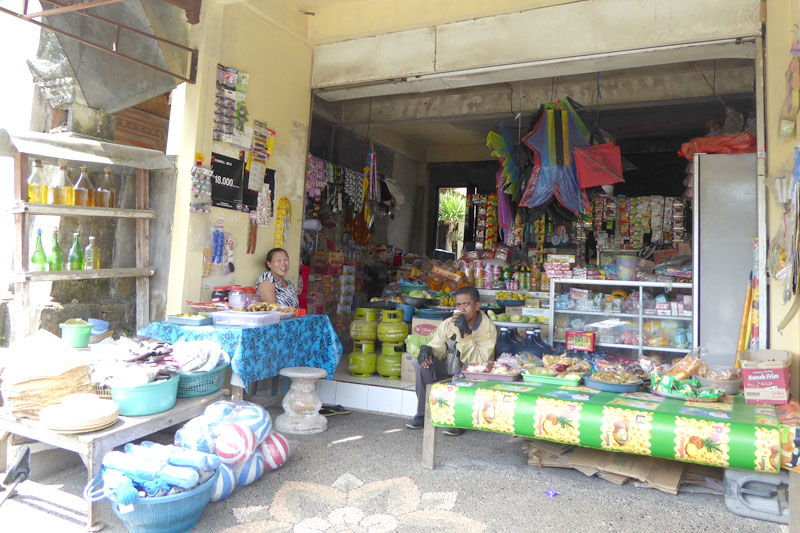
This is a warung right outside where I live. I usually come here to buy bananas from the lovely auntie in the picture. She doesn’t know English so sometimes she needs to show me the exact money notes to indicate the price of my purchase.
Livestock
Something I find intriguing about Ubud is how animals roam freely on the streets. You will see chickens and dogs walking around unattended. Geese are around too, but usually in the rice fields.
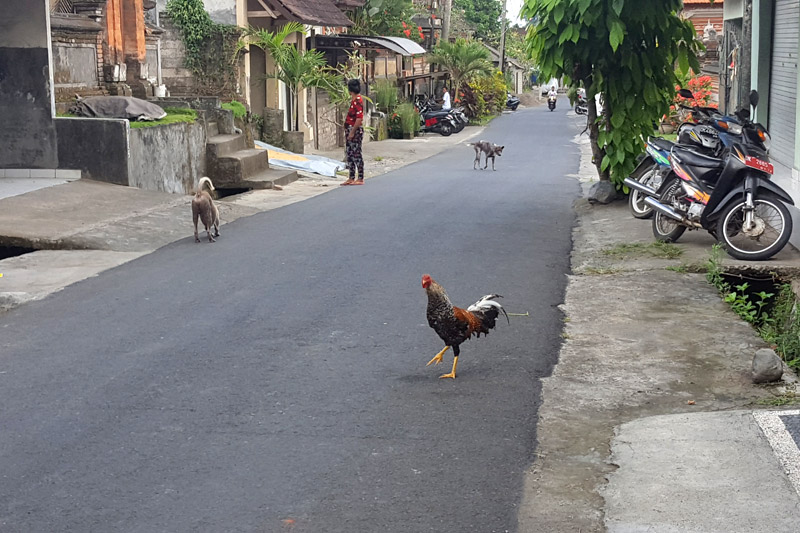
Chickens and dogs just walking around, doing their thing
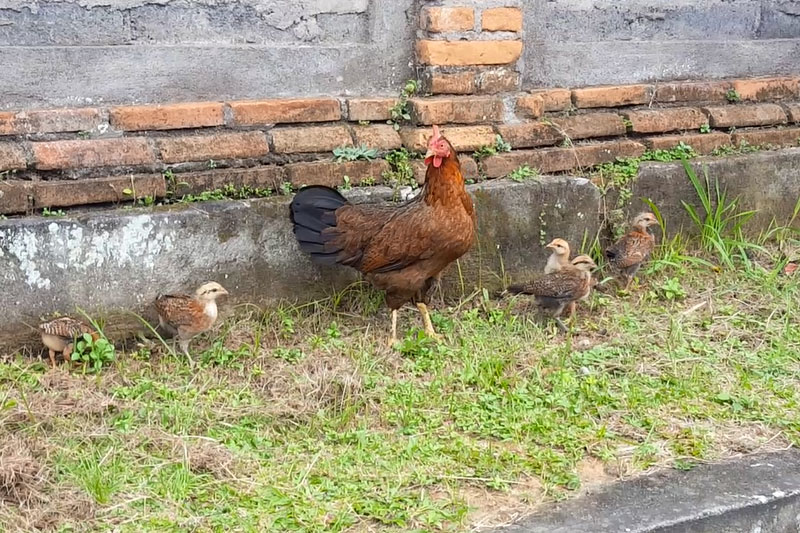
Mama hen with her chicks :)
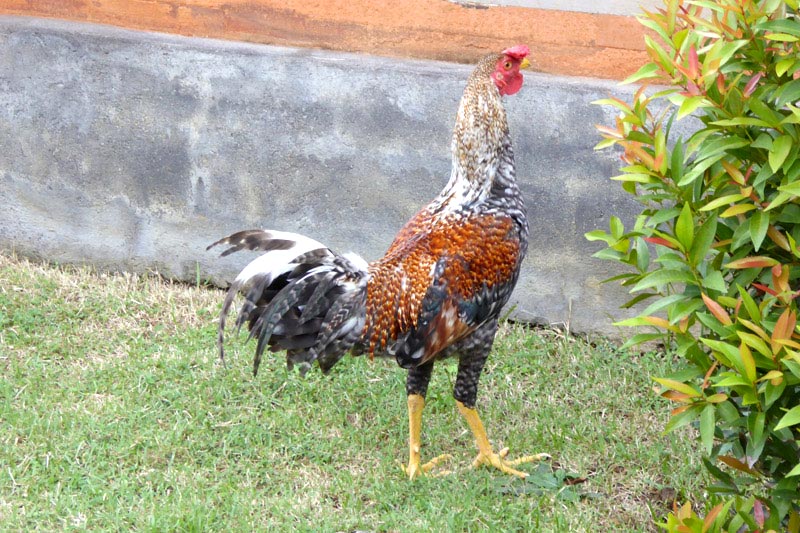
A rooster. You usually find roosters kept inside weaved baskets along the roads.
My homeowner told me that they breed cockerels for cockfighting before religious ceremonies as an offering to the gods. Cockfighting is quite a big national sport as crowds of local men will gather and place bets or simply watch as entertainment. It’s a fight to the death so one cock will die — sometimes both get mortally injured. I thought it’s a cruel sport but I didn’t say anything; I didn’t feel it was in my place to comment as a foreigner. Apparently, cockfighting has its origins in Balinese Hinduism — it’s believed that the spilling of blood will appease evil spirits and keep them from causing disturbances.[4] Read about cockfighting and its role in the Balinese culture here.
Dogs — Be Careful of Dogs Biting
Next, dogs. There are many dogs in Ubud. These aren’t just small puppy dogs but large dogs as big as a German Shepherd — and running around without a leash. I was told that dogs are regarded as “protectors” in the Balinese culture, similar to other cultures I suppose. I’ve even seen dogs ride on scooters with their owners, which I thought is quite cute!

Beautiful white dog. That’s how large the average dog here is.
Some dogs at the villages bark quite ferociously at people, especially unfamiliar folks (people like you and me who are non-locals). Not at Ubud Center though, where the dogs are used to having flocks of unfamiliar people walk by every day. It’s not something to take lightly by the way — the local hospital, as a matter of fact, deals with dog bite injuries daily! Here is an account of someone who got bitten by an Ubud dog despite not provoking it and here is an account of someone who got bitten when trying to feed one.
My closest “crazy” encounter with a dog happened during my second day in the countryside when I was trying to walk to a nearby restaurant for dinner. It was 7 pm so the streets were completely dark. Like I said above, it gets dark fast here and there are no street lamps, so you don’t want to be walking alone in a village at night.
As I walked on the road to the restaurant, I realized that there was a big dog some distance away — and it got up and started barking. The closer I walked, the louder it barked. Realizing that it was barking at me and not just barking randomly (there was no one else there), I slowly turned 180 degrees and started slow-walking back the path I came from. The dog barked louder while following me from behind, seemingly trying to close the gap between us.
What happened next? Because I was really close to my accommodation, I was able to get behind the gates quickly and asked my host to drive me to the restaurant on his scooter. Thank god too, because I think it’s quite possible that the dog might have given chase if I wasn’t able to seek refuge. -_-
My lessons learned? If you’re living in a village,
- Do not walk along the village streets after 6 pm, at least not alone. I’ve noticed that the dogs here tend to get more agitated after dark than in the day.
- Avoid the dogs at all costs.
- If you are walking and you see a dog from a distance, deliberately walk on the pathway that it’s NOT on.
- I read this somewhere — do NOT have eye contact with the dog. Just look into the distance, walk briskly, pretend it doesn’t exist, and go about your daily business. Apparently, dogs can detect fear, so the more scared you are, the more it will feel that something is off and start barking at you, possibly giving chase. Honestly, it’s quite hard not to feel scared when you have a large dog barking madly at you and within a few inches away, so the easiest is just to follow the first three tips.
These tips don’t apply in Ubud Center. When I was living there, I had absolutely no issues walking next to and around dogs.
Just to clarify, most dogs here will NOT bite if you just leave them alone. But it’s good to play safe, and that’s where the tips above will help. :)
In the next part, I share about transport options in Ubud. Read: Living in Ubud, Transport: Scooters, Taxis, and Go-Jek
This is part 2 of a 5-part travel series on Ubud where I share things to note as a foreigner living in Ubud and how to make the best out of your trip here.
- Part 1: Living in Ubud Series: Introduction, Visa, Accommodation
- Part 2: Environment: Nature, Climate, Villages, Animals
- Part 3: Transport: Scooters, Taxis, Go-Jek
- Part 4: Food: Vegan & Vegetarian Restaurant Reviews
- Part 5: Others: Insects, Language, Internet Speed, and More (Conclusion)
(Images: Ubud, Rice field, Bali climate, Tegalalang rice terrace, Farmer, All other images © Personal Excellence)


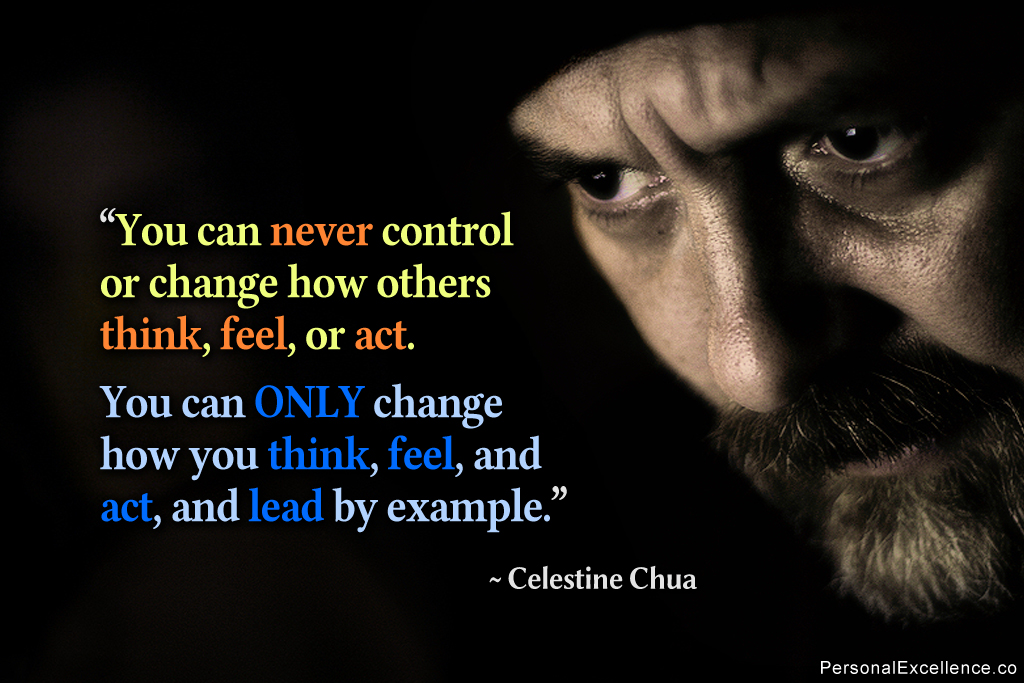
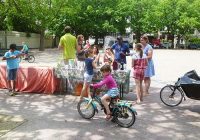
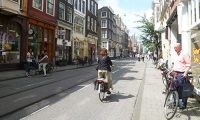




 Thanks for reading. If you like my free articles, join my private email list and get my latest updates and articles sent right to your inbox.
Thanks for reading. If you like my free articles, join my private email list and get my latest updates and articles sent right to your inbox.